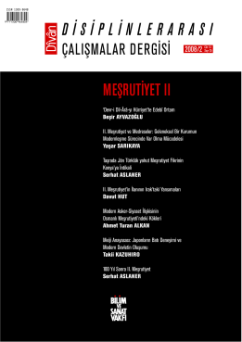25
Meşrutiyetin ikinci defa ilanının 100. yılı münasebetiyle Osmanlı başta olmak üzere aynı dönemde farklı ülkelerin meşrutiyet tecrübelerini ele almayı hedefleyerek Meşrutiyet konusuna tahsis ettiğimiz özel sayılarımızın ikincisiyle karşınızdayız.
Articles
This article aims to discuss various academic activities organized on the occasion of the centennial of the proclamation of the Ottoman constitution in 1908. It first briefly discuss the main aspects of these activities; it then presents a list of the symposia organized in Turkey and abroad, and the papers presented in these conferences, as well as the articles published in the periodicals with special issues devoted to the Second Constitutional Period.
Serhat ASLANERIn this essay, literary milieu of the first five years of the Second Constitutional Period will be described. Although the main topic of the many short lived newspapers and journals was enmity to Abdulhamid II, poets like Tevfik Fikret, Abdülhak Hamid, Rıza Tevfik and Mehmet Akif as strong voices of this period dominated the literary milieu. Yeni Lisan (the new language) movement initiated by Ömer Seyfeddin and Turkism led by Ziya Gökalp, after the Balkan Wars, with the support of the Committee of Union and Progress, were on the way to become a new literary focus. One could argue that the polemic between the Fecr-i Ati (the coming dawn) and the New Language groups as well as struggles between Mehmet Akif and Tevfik Fikret dominated the literary discussions during the early years of the Second Constitutional Period. As a continuation of the Edebiyat-ı Cedide (new literature), despite its weaknesses the Fecr_i Ati paved the way for the emergence of strong figures like Ahmet Haşim, Yakup Kadri and Refik Halid whereas Köprülüzade Fuad and Hamdullah Suphi left it for new Language Movement. In this environment, Halide Edip emerged as a strong women novelist and supported Turkism with her novel, Yeni Turan. This period also constituted the background for the National Literary Movement which essentially emerged during the war years.
Beşir AYVAZOĞLUThe education system in general and religious education in particular were two of the most important questions to be solved during the modernization process, which was accelerated by the Tanzimat reforms. These questions were not yet solved by the time the Second Constitutional period started in 1908. Ignored for decades, the madrasas began to fight for survival much more intensely than they had done in the earlier periods. In this connection, a series of reform programs were launched, and new projects for madrasas were designed. These were done with the purpose of re-constructing the religious education while at the same time preserving the traditional system. The madrasa curricula were re-organized with the addition of modern courses. The overall aim of all these reforms was to help the madrasa return to its central place in the Ottoman education system. However, all these efforts and the reforms launched for the madrasa system were not effective enough to prolong its life. Eventually, the madrasas were closed down in 1924, before reaping the fruits of the reforms that had been undertaken during the Second Constitutional period, each of which was a product of a mixture of vast knowledge and rich historical experiences. Despite this, however, these experiences were useful in terms of the emergence and development of the Religious High Schools and Schools of Divinity, which replaced the madrasas during the Republican period.
Yaşar SARIKAYAThis article explores the question how and when the constitutionalist ideas were disseminated in the Ottoman provinces before the proclamation of the constitution in 1908. Focusing on the Konya province, it also examines the sources of the reactions to the constitution, which were mostly in line with the political centers view point. In this context, it argues that the circulation of these ideas was intensified particularly during the second half of the 1890s, and that different groups, including first and foremost the Ottoman exiles as well as the ulamâ and sheikhs, and bureaucrats of different ranks, played important roles in the process of the dissemination of the constitutionalist ideas.
Serhat ASLANERThe article aims to analyze the reflections of the proclamation of Second Constitution in Iraq. By this means, some sections were presented from Baghdad, Basrah and Mosul Provinces which formed Iraq. Such proclamation was generally received suspiciously and unwanted situation in these provinces. Appearing disorder and tension caused some important political and social events which ruined security and public order in Iraq.
Davut HUTThe Ottoman modernization is not a unique process or an exceptional case among other forms of modernization. It is an indispensable consequence of this process that there emerges an ideological conflict between those social classes and groups that are open to modernization and those that are not. In the Ottoman case, this conflict was fully experienced during the short period between the proclamation of the Ottoman constitution in 1908 and the start of World War I in 1914. The conflict emerged particularly between the traditional ideology that the Ottoman Palace adopted and the West-oriented, modernist ideology that was embraced by the army and the civil bureaucracy, which were the two strongholds of the modernist groups. This ideological struggle resulted in the defeat of the Ottoman dynasty and the Palace. The victorious army and bureaucracy that won the fight then reshaped the state and its ideology based on the Western-oriented modernist one. This article aims to briefly shed light on the relationships between the Ottoman army and the new ruling elite during the process of the emergence of modern Turkey.
Ahmet Turan ALKANThis essay is a detailed examination of the intellectual and cultural history that gave birth to Japans Meiji Constitution at the end of the nineteenth century. In it a cross-cultural perspective is employed to analyze how modern Western ideas of constitutional government were assimilated and adapted by the newly established Meiji state. It also looks beyond the constitution as a legal document and demonstrates how its architects used it and the supplementary laws and institutions supporting it to catalyze the emergence of a modern nation-state.
Takii KAZUHIRO





